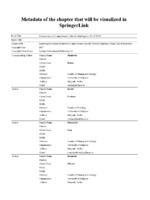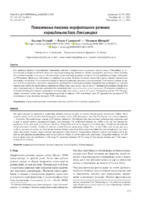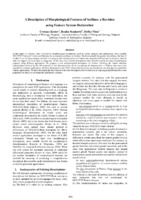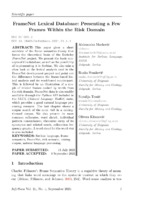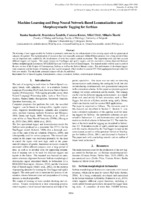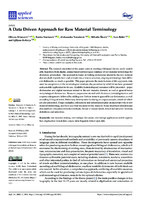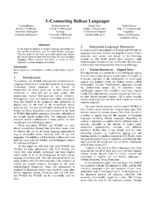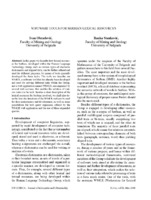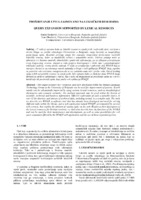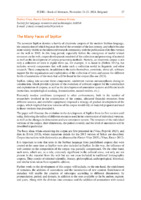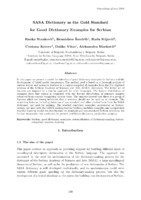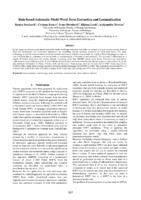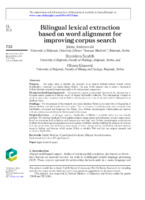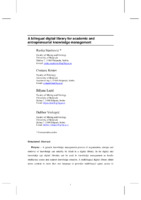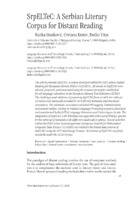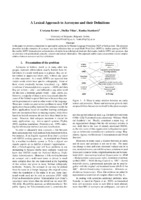Претрага
242 items
-
Improving Document Retrieval in Large Domain Specific Textual Databases Using Lexical Resources
Large collections of textual documents represent an example of big data that requires the solution of three basic problems: the representation of documents, the representation of information needs and the matching of the two representations. This paper outlines the introduction of document indexing as a possible solution to document representation. Documents within a large textual database developed for geological projects in the Republic of Serbia for many years were indexed using methods developed within digital humanities: bag-of-words and named ...Ranka Stanković, Cvetana Krstev, Ivan Obradović, Olivera Kitanović. "Improving Document Retrieval in Large Domain Specific Textual Databases Using Lexical Resources" in Trans. Computational Collective Intelligence - Lecture Notes in Computer Science 26, Springer (2017). https://doi.org/10.1007/978-3-319-59268-8_8 M33
-
Повезивање лексема морфолошких речника коришћењем базе Лексимирка
Рад приказује приступ успостављању повезивања лексема у Морфолошким речницима српског језика. Повезивање, тј. успостављање релација не би било могуће без претходне конверзије речника из облика текстуалних датотека у облик лексичке базе података назване Лексимирка. Методологија за успостављање релација почива на 69 појединачних релација заснованих на 388 правила. Правила за повезивање се дефинишу на основу обележја лексичких записа (врсте речи, маркера, граматичких категорија и подниски). Успостављене релације су крајњем кориснику видљиве путем апликације Лексимирка у форми хипервеза и могу се ...Биљана Рујевић, Ранка Станковић, Михаило Шкорић. "Повезивање лексема морфолошких речника коришћењем базе Лексимирка" in Модерни речници у функцији просечнога корисника: стари проблеми, савремени правци и нови изазови, Лексикографски сусрети, Београд, 27-29. мај 2024. , Београд : Филолошки факултет (2024). https://doi.org/10.18485/lexicog_meet.2024.1.ch23 М33
-
Two approaches to compilation of bilingual multi-word terminology lists from lexical resources
In this paper, we present two approaches and the implemented system for bilingual terminology extraction that rely on an aligned bilingual domain corpus, a terminology extractor for a target language, and a tool for chunk alignment. The two approaches differ in the way terminology for the source language is obtained: the first relies on an existing domain terminology lexicon, while the second one uses a term extraction tool. For both approaches, four experiments were performed with two parameters being ...Branislava Šandrih, Cvetana Krstev, Ranka Stanković. "Two approaches to compilation of bilingual multi-word terminology lists from lexical resources" in Natural Language Engineering, Cambridge University Press (CUP) (2020). https://doi.org/10.1017/S1351324919000615 М21
-
A Description of Morphological Features of Serbian: a Revision using Feature System Declaration
In this paper we discuss some well-known morphological descriptions used in various projects and applications (most notably MULTEXT-East and Unitex) and illustrate the encountered problems on Serbian. We have spotted four groups of problems: the lack of a value for an existing category, the lack of a category, the interdependence of values and categories lacking some description, and the lack of a support for some types of categories. At the same time, various descriptions often describe exactly the same ...Cvetana Krstev, Ranka Stanković, Vitas Duško. "A Description of Morphological Features of Serbian: a Revision using Feature System Declaration" in Proceedings of the 5th International Conference on Language Resources and Evaluation, LREC 2010, Valetta, Malta : European Language Resources Association (2010) M33
-
FrameNet Lexical Database: Presenting a Few Frames Within the Risk Domain
U radu se daje kratak prikaz teorije semantike okvira, na kojoj je zasnovana leksička baza Frejmnet. Predstavljena je koncepcija ove mreže, kao i mogućnosti njene primene. Predstavljena je i leksička analiza koja se primenjuje u projektu izrade Frejmneta i ukazano na razlike između analize zasnovane na okviru u odnosu na analizu zasnovanu na reči. Zatim je prikazano nekoliko povezanih okvira koje prizivaju reči iz domena rizika. U radu je predstavljena i platforma NLTК pomoću koje se mogu koristiti ...Aleksandra Marković, Ranka Stanković, Natalija Tomić, Olivera Kitanović. "FrameNet Lexical Database: Presenting a Few Frames Within the Risk Domain" in Infotheca, Faculty of Philology, University of Belgrade (2021). https://doi.org/10.18485/infotheca.2021.21.1.1 М53
-
Machine Learning and Deep Neural Network-Based Lemmatization and Morphosyntactic Tagging for Serbian
The training of new tagger models for Serbian is primarily motivated by the enhancement of the existing tagset with the grammatical category of a gender. The harmonization of resources that were manually annotated within different projects over a long period of time was an important task, enabled by the development of tools that support partial automation. The supporting tools take into account different taggers and tagsets. This paper focuses on TreeTagger and spaCy taggers, and the annotation schema alignment ...Ranka Stanković, Branislava Šandrih, Cvetana Krstev, Miloš Utvić, Mihailo Škorić. "Machine Learning and Deep Neural Network-Based Lemmatization and Morphosyntactic Tagging for Serbian" in Proceedings of the 12th Language Resources and Evaluation Conference, May Year: 2020, Marseille, France, European Language Resources Association (2020) М33
-
A Data Driven Approach for Raw Material Terminology
Olivera Kitanović, Ranka Stanković, Aleksandra Tomašević, Mihailo Škorić, Ivan Babić, Ljiljana Kolonja (2021)The research presented in this paper aims at creating a bilingual (sr-en), easily searchable, hypertext, born-digital, corpus-based terminological database of raw material terminology for dictionary production. The approach is based on linking dictionaries related to the raw material domain, both digitally born and printed, into a lexicon structure, aligning terminology from different dictionaries as much as possible. This paper presents the main features of this approach, data used for compilation of the terminological database, the procedure by which it has ...sirovine, rudarstvo, terminologija, rečnik, terminološka aplikacija, mobilna aplikacija, digitizacija, leksički podaci, korpusi, otvoreni povezani podaciOlivera Kitanović, Ranka Stanković, Aleksandra Tomašević, Mihailo Škorić, Ivan Babić, Ljiljana Kolonja. "A Data Driven Approach for Raw Material Terminology" in Applied Sciences, MDPI AG (2021). https://doi.org/10.3390/app11072892 М22
-
E-Connecting Balkan Languages
In this paper we present a versatile language processing tool that can be successfully used for many Balkan languages. This tool relies for its work on several sophisticated textual and lexical resources that were developed for most of Balkan languages. These resources are based on several de facto standards in natural language processing.Cvetana Krstev, Ranka Stanković, Duško Vitas, Svetla Koeva. "E-Connecting Balkan Languages" in Proceedings of the Workshop Workshop on Multilingual resources, technologies and evaluation for Central and Eastern European Languages, 17 September 2009, eds. C. Vertan, S. Piperidis, E. Paskaleva and Milena Slavcheva, Borovets, Bulgaria : Association for Computational Linguistics Stroudsburg, PA, USA (2009) M33
-
Managing mining project documentation using human language technology
Purpose: This paper aims to develop a system, which would enable efficient management and exploitation of documentation in electronic form, related to mining projects, with information retrieval and information extraction (IE) features, using various language resources and natural language processing. Design/methodology/approach: The system is designed to integrate textual, lexical, semantic and terminological resources, enabling advanced document search and extraction of information. These resources are integrated with a set of Web services and applications, for different user profiles and use-cases. Findings: The ...Digital libraries, Information retrieval, Data mining, Human language technologies, Project documentationAleksandra Tomašević, Ranka Stanković, Miloš Utvić, Ivan Obradović, Božo Kolonja . "Managing mining project documentation using human language technology" in The Electronic Library (2018). https://doi.org/10.1108/EL-11-2017-0239 М23
-
Softverski alati za korišćenje resursa za srpski jezik
Ivan Obradović, Ranka Stanković (2008)Ivan Obradović, Ranka Stanković. "Softverski alati za korišćenje resursa za srpski jezik" in INFOteka: časopis za informatiku i bibliotekarstvo, Belgrade, Serbia : Zajednica biblioteka univerziteta u Srbiji (2008) M52
-
Proširivanje upita zasnovano na leksičkim resursima
U radu je opisano kako se leksički resursi za srpski jezik i softverski alati, razvijeni u okviru Grupe za jezičke tehnologije Univerziteta u Beogradu, mogu koristiti za unapređenje postavljanja upita. Rezultati pretrage mogu biti značajno unapređeni korišćenjem različitih leksičkih resursa, kakvi su morfološki rečnici i semantičke mreže. Izloženi pristup može se iskoristiti i u Sistemu naučnih, tehnoloških i poslovnih informacija, jer je efikasno pretraživanje ovog dragocenog resursa, imajući u vidu njegovu heterogenost i obim, kao i preovladavajući tekstualni sadržaj, ...Ranka Stanković, Ivan Obradović, Cvetana Krstev. "Proširivanje upita zasnovano na leksičkim resursima" in SNTPI 09 - Naučno-stručni skup Sistem naučnih, tehnoloških i poslovnih informacija, Beograd 19. i 20. jun 2009, Beograd : Fakultet informacionih tehnologija (2009) M63
-
Possibilities of retro-digitalized German-Serbian Mining Dictionary
U radu će biti prikazan opis procesa retrodigitalizacije dvojezičnog Nemačko-srpskog rudarskog rečnika iz 1923. godine čiji je autor rudarski inženjer Dragutin Stepanović (Степановић, 1923). Ovaj rečnik je zasnovan na skoro 4 000 leksičkih zapisa koji su prevodilački ekvivalenti ili uputnice. Umesto predgovora autor daje uvid u svoje pismo upućeno “Ministru šuma i rudnika” u kome piše o nameri da zabeleži reči koje se koriste u narodu kako bi izbegao upotrebu nemačkih reči. Iako broj odrednica nije toliko veliki, rečnik ...Biljana Lazić, Olivera Kitanović, Ivan Obradović. "Possibilities of retro-digitalized German-Serbian Mining Dictionary" in E-dictionaries and E-lexicography, Zagreb, 10-11 May 2019, Zagreb : Institut za hrvatski jezik i jezikoslovlje (2019) М34
-
The Many Faces of SrpKor
Акроним СрпКор означава фамилију електронских корпуса савременог српског језика чија је изградња почела крајем седамдесетих година прошлога века, а која је постала шире видљива заинтересованој истраживачкој заједници објављивањем његове прве верзије на вебу 2002. године. У овом дугом периоду, посебно пре појаве корисних текстуелних ресурса на вебу, развој корпуса се састојао у прикупљању и обради грађе као и у развоју метода обраде корпуса. Наиме, електронски корпус није само колекција текстова у дигиталном облику (како се то, на пример, наводи ...Duško Vitas, Ranka Stanković, Cvetana Krstev. "The Many Faces of SrpKor" in South Slavic Languages in the Digital Environment JuDig Book of Abstracts, University of Belgrade - Faculty of Philology, Serbia, November 21-23, 2024, University of Belgrade - Faculty of Philology (2024.) М64
-
SASA Dictionary as the Gold Standard for Good Dictionary Examples for Serbian
Ranka Stanković, Branislava Šandrih, Rada Stijović, Cvetana Krstev, Duško Vitas, Aleksandra Marković (2019)У овом раду представљамо модел за избор добрих примера за речник српског језика и развој иницијалних компоненти модела. Метода која се користи заснива се на детаљној анализи различитих лексичких и синтактичких карактеристика у корпусу састављених од примера из пет дигитализованих свезака речника САНУ. Почетни скуп функција био је инспирисан сличним приступом и за друге језике. Дистрибуција карактеристика примера из овог корпуса упоређује се са карактеристиком дистрибуције узорака реченица ексцерпираних из корпуса који садрже различите текстове. Анализа је показала да ...Српски, добри примери из речника, аутоматизација израде речника, издвајање својстава, Машинско учењеRanka Stanković, Branislava Šandrih, Rada Stijović, Cvetana Krstev, Duško Vitas, Aleksandra Marković. "SASA Dictionary as the Gold Standard for Good Dictionary Examples for Serbian" in Electronic lexicography in the 21st century. Proceedings of the eLex 2019 conference , Lexical Computing CZ, s.r.o. (2019) М33
-
Rule-based Automatic Multi-word Term Extraction and Lemmatization
In this paper we present a rule-based method for multi-word term extraction that relies on extensive lexical resources in the form of electronic dictionaries and finite-state transducers for modelling various syntactic structures of multi-word terms. The same technology is used for lemmatization of extracted multi-word terms, which is unavoidable for highly inflected languages in order to pass extracted data to evaluators and subsequently to terminological e-dictionaries and databases. The approach is illustrated on a corpus of Serbian texts from ...Ranka Stanković, Cvetana Krstev, Ivan Obradović, Biljana Lazić, Aleksandra Trtovac. "Rule-based Automatic Multi-word Term Extraction and Lemmatization" in Proceedings of the 10th International Conference on Language Resources and Evaluation, LREC 2016, Portorož, Slovenia, 23--28 May 2016, European Language Resources Association (2016) M33
-
Keyword-Based Search on Bilingual Digital Libraries
This paper outlines the main features of Biblisha, a tool that offers various possibilities of enhancing queries submitted to large collections of aligned parallel text residing in bilingual digital library. Biblishsa supports keyword queries as an intuitive way of specifying information needs. The keyword queries initiated, in Serbian or English, can be expanded, both semantically, morphologically and in other language, using different supporting monolingual and bilingual resources. Terminological and lexical resources are of various types, such as wordnets, electronic ...Ranka Stanković, Cvetana Krstev, Duško Vitas, Nikola Vulović, Olivera Kitanović. "Keyword-Based Search on Bilingual Digital Libraries" in Semantic Keyword-Based Search on Structured Data Sources - Second COST Action IC1302 International KEYSTONE Conference, IKC 2016, Springer (2017). https://doi.org/10.1007/978-3-319-53640-8_10 M14
-
Bilingual lexical extraction based on word alignment for improving corpus search
Jelena Andonovski, Branislava Šandrih, Olivera Kitanović. "Bilingual lexical extraction based on word alignment for improving corpus search" in The Electronic Library, Emerald (2019). https://doi.org/10.1108/EL-03-2019-0056 М23
-
A bilingual digital library for academic and entrepreneurial knowledge management
A generic knowledge management process of organization, storage and retrieval of knowledge can suitably be fitted in a digital library. In the digital and knowledge age digital libraries can be used in knowledge management to handle intellectual assets and support knowledge creation. A multilingual digital library either stores content in more than one language or provides multilingual query access to monolingual content. In Serbia 18 of 308 scientific journals regularly published are bi-lingual, with papers simultaneously being in English ...Ranka Stanković, Cvetana Krstev, Biljana Lazić, Dalibor Vorkapić. "A bilingual digital library for academic and entrepreneurial knowledge management" in Proceeding of 10th International Forum on Knowledge Asset Dynamics — IFKAD 2015: Culture, Innovation and Entrepreneurship: connecting the knowledge dots, Bari, Italy, 10-12 June 2015, Bari : IFKAD (2015) M33
-
SrpELTeC: A Serbian Literary Corpus for Distant Reading
U članku je predstavljen SrpELTeC, korpus razvijen u okviru akcije COST Distant Reading for European Literary History (CA16204). Svi romani u SrpELTeC-u su odabrani, pripremljeni i obeleženi korišćenjem zajedničkih principa uspostavljenih za sve jezičke zbirke u Evropskoj zbirci književnog teksta (ELTeC). Navedeni su izazovi i rešenja u pripremi SrpELTeC od nule. Svi romani su ručno kodirani u TEI sa bogatim metapodacima i strukturnim napomenama. Automatska anotacija je uključivala POS-označavanje, lematizaciju i imenovane entitete, oslanjajući se na resurse za obradu ...digital humanities, Serbian literature, text corpora, distant reading , linked data, named entity recognition, text analyticsRanka Stanković, Cvetana Krstev, Duško Vitas. "SrpELTeC: A Serbian Literary Corpus for Distant Reading" in Primerjalna književnost, Research Centre of the Slovenian Academy of Sciences and Arts (2024). https://doi.org/10.3986/pkn.v47.i2.03 М23
-
A Lexical Approach to Acronyms and their Definitions
In this paper we present a comprehensive approach to acronyms for Natural-Language Processing (NLP) of Serbian texts. The proposed procedure includes extraction of acronyms and their definitions that are usual Multi-Word Units (MWUs), shallow parsing of MWUs that enables MWU lemmatization and production of entries in morphological electronic dictionaries, both for MWU and acronyms, that are provided with grammatical, syntactic, semantic and domain information. This approach enables representation that reflects complex relations between acronyms and their definitions.Cvetana Krstev, Duško Vitas, Ranka Stanković. "A Lexical Approach to Acronyms and their Definitions" in Proceedings of the 7th Language & Technology Conference, November 27-29, 2015, Poznań, Poland, Springer (2015) M33
